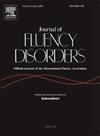左丘脑深部脑刺激治疗持续性发育性口吃
IF 2.1
3区 医学
Q1 AUDIOLOGY & SPEECH-LANGUAGE PATHOLOGY
引用次数: 0
摘要
背景和目的持续性发育性口吃是一种常见的语言流利障碍,可显著降低生活质量。由于现有的治疗方法并不总是提供令人满意的结果,因此需要新的治疗方法。口吃者异常的大脑言语网络为神经调节提供了基础。我们在此报告深部脑刺激(DBS)首次用于治疗口吃的有效性。方法对一名自幼严重口吃的24岁男性患者进行为期两年的盲法左腹侧丘脑中间核慢性电刺激。使用口吃严重程度量表第四版(SSI-4)确定口吃频率为口吃音节百分比和口吃严重程度。成人说话者口吃经历总体评估(OASES-A)问卷量化了患者对口吃经历和生活质量的自我评估。结果术后平均结巴频率降低46% %,结巴严重程度降低29% %。最大口吃频率降低62% %,口吃严重程度降低39% %;口吃的自我评估提高了38% %。口吃频率与DBS刺激频率呈负相关,表明生物刺激效应超过任何潜在的安慰剂效应。口吃对刺激参数变化的反应滞后数周,说明深部脑刺激对口吃的调节作用较直接抑制作用缓慢。结论脑深部电刺激是治疗重度口吃的一种新方法,值得进一步在口吃患者中进行系统的探索。本文章由计算机程序翻译,如有差异,请以英文原文为准。
Left thalamic deep brain stimulation for persistent developmental stuttering
Background and purpose
Persistent developmental stuttering is a frequent speech fluency disorder that can considerably reduce quality of life. Because available therapies do not always provide satisfying results, new therapeutic approaches are needed. The anomalous cerebral speech network in persons who stutter provides substrate for neuromodulation. We report here the effectiveness of deep brain stimulation (DBS) used for the first time to treat stuttering.
Methods
A 24-year-old male who stuttered severely since childhood received chronic left ventral intermediate thalamic nucleus electrical stimulation following a patient- and examiners-blinded two-year stimulation protocol. Stuttering frequency was determined as percent stuttered syllables and stuttering severity using the Stuttering Severity Instrument – 4th edition (SSI-4). The Overall Assessment of the Speaker's Experience of Stuttering – Adults (OASES-A) questionnaire quantified the patient’s self-evaluated experience of stuttering and quality of life.
Results
The average stuttering frequency decreased by 46 % postoperatively and the stuttering severity by 29 %. The maximal achieved reduction of stuttering frequency was 62 % and of stuttering severity 39 %; self-assessment of stuttering improved by 38 %. Stuttering frequency was negatively associated with DBS stimulation frequency, demonstrating a biological stimulation effect beyond any potential placebo effects. Stuttering responded to stimulation parameter changes with a lag of several weeks, pointing to a rather slow modulatory than direct suppressive effect of deep brain stimulation on stuttering.
Conclusion
These results suggest deep brain stimulation as a new treatment option for severe stuttering and warrant further systematic exploration in a series of people who stutter.
求助全文
通过发布文献求助,成功后即可免费获取论文全文。
去求助
来源期刊

Journal of Fluency Disorders
AUDIOLOGY & SPEECH-LANGUAGE PATHOLOGY-REHABILITATION
CiteScore
3.70
自引率
14.30%
发文量
23
审稿时长
>12 weeks
期刊介绍:
Journal of Fluency Disorders provides comprehensive coverage of clinical, experimental, and theoretical aspects of stuttering, including the latest remediation techniques. As the official journal of the International Fluency Association, the journal features full-length research and clinical reports; methodological, theoretical and philosophical articles; reviews; short communications and much more – all readily accessible and tailored to the needs of the professional.
 求助内容:
求助内容: 应助结果提醒方式:
应助结果提醒方式:


